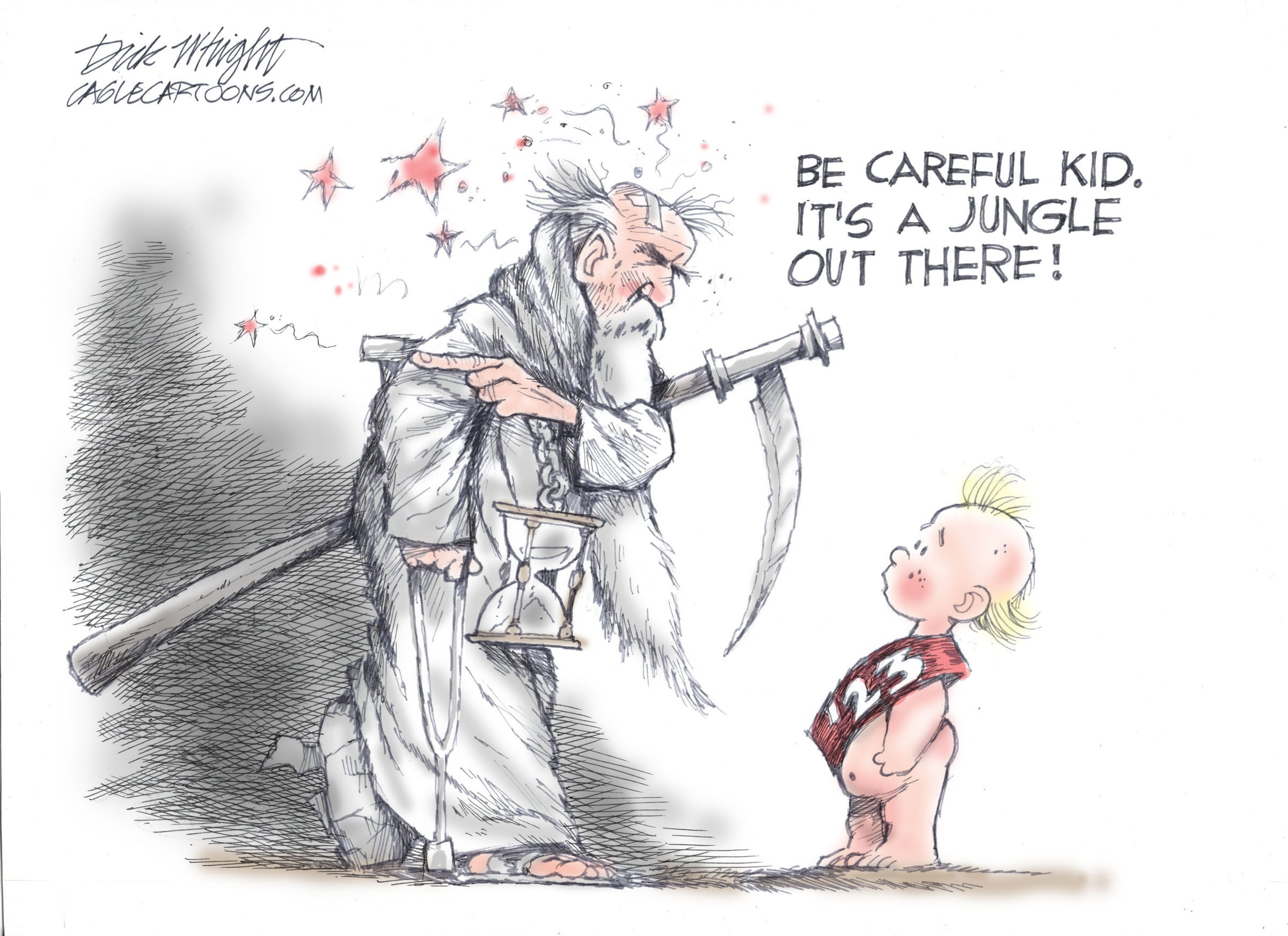
2022 included a lot of suffering and loss.
But if recent trends continue, we might look back on it as a turning point.
In his six-volume history of World War II, Winston Churchill named the fourth volume — the one that covered 1942 — The Hinge of Fate. To the people living through 1942, I doubt it looked all that wonderful. But from the perspective of the Allies’ eventual victory, it was the year when everything turned around.
There’s reason to hope we might look back on 2022 that way, someday.
2022 was a year when the bottom did not fall out. It tempted us to imagine many horrible outcomes, which then did not come to pass. It was a year of dodged bullets.
That’s what a hinge year looks like.
At the end of 1941, it would have been easy to imagine a total Axis victory. Hitler had overwhelmed Western Europe and conquered the Balkans. Now German troops were just outside Moscow, and he seemed on the verge of driving the British out of Egypt. Japan had crippled the US Navy at Pearl Harbor, and its troops were advancing throughout Southeast Asia. Both Singapore and the Philippines would fall in the first half of 1942.
But 1942 began with Russia’s winter campaign inflicting enormous casualties on the Nazi forces. In May and June the US Navy had defensive victories in the Coral Sea and at Midway. In July, the British stopped Rommel’s advance at El Alamein. By the end of 1942 the battle of Stalingrad, which the Soviets would win decisively in early 1943, had begun.
On New Years Day in 1943, I doubt a lot of Americans believed they were on a glide path to victory. If we had lost the battles of Coral Sea and Midway, Australia and Hawaii might have fallen. Stalingrad was still in doubt. Rommel might regroup and start advancing again. Only in retrospect, when the dodged bullets of 1942 led to a string of victories in 1943-45, did 1942 look like a hinge year. But that’s how historians think of it now.
Now think about 2022. A year ago, Russian troops were massing around Ukraine, Covid had developed its new Omicron variant, and pundits were predicting a 2010/1994-style red wave in the fall elections. Worse than the simple prospect of a Republican Congress, backers of Trump’s big lie were running for secretary of state in all the purple states, setting up the possibility of a better-organized coup in 2024. Trump himself had survived the brief spasm of Republican conscience after January 6, and was firmly in control of the party again. A House committee was investigating January 6, but no one knew what it was finding. By the time it told the public anything, would people still care? And even if it uncovered evidence against Trump, did Merrick Garland have the balls to do anything about it? Like Trump, Jair Bolsonaro was running for a second term in Brazil. As we know from the previous examples of Hungary and India, the second term is when fascism consolidates.
Democracy, both at home and overseas, was losing.

Ukraine. In February, Russia opened a full invasion of Ukraine, with the announced intention of ending the fiction of Ukrainian statehood. The Ukrainians seemed outmanned and outgunned. This vision seemed very plausible:
Consider the following scenario: the front lines are in shambles, the army has been defeated, the road to Kyiv is clear, and the West imposes more sanctions but refuses to go to war. In Ukraine’s capital city, riots erupt in large numbers. Protesters call on the government to step down. Armed groups storm government buildings throughout the country as riots swiftly turn violent. President Zelensky, along with a portion of the pro-Western elite, resigns and departs the country. A transitional administration is built around a simple agenda: sign an immediate ceasefire with Russia (or with whomever Russia chooses, such as the Donetsk or Luhansk People’s Republic) under any circumstances, and organize a constituent assembly election.
President Biden wanted to help the Ukrainians, but would NATO follow his lead? NATO’s unity of purpose and trust in American leadership had decayed badly during the Trump years, when the American president had openly wondered whether newer NATO members like Montenegro were worth defending, and seemed to hold Vladimir Putin in much higher regard than any democratic leader.
So where would NATO be, after Ukraine fell? Perhaps it would splinter, leaving its more exposed members (like the Baltic republics) open to Russia bullying.
None of that happened.
Instead, national independence turned out to mean a great deal to Ukrainians, who rallied around President Zelenskyy as a Churchillian figure. President Biden did a masterful job reuniting NATO around its original purpose of stopping Russian aggression. Finland and Sweden have applied for NATO membership.
The Russian military proved not to be the efficient machine everyone had imagined. It suffered from weak morale, bad planning, and poor equipment. In the north, its forces have been thrown back completely. In the west and south, they have been retreating since summer.
But hinge years are not victorious romps. All this has come at tremendous cost.
For the US, that cost has been almost entirely financial: In 2022 we spent $23 billion on military aid for Ukraine and an additional $25 billion in non-military aid. The recently passed FY 2023 omnibus spending bill included an additional $45 billion. Sanctions on Russian oil and gas undoubtedly have contributed to our inflation, but US troops are not dying and missiles are not falling on American cities.
The direct suffering is being borne by Ukrainians. Casualty estimates are unreliable, but both civilian and military deaths are likely in the tens of thousands. Nearly 8 million Ukrainians (out of a pre-war 41 million, not counting Crimea) are estimated to have fled the country. As of September, one independent estimate of damage to Ukraine’s infrastructure was $127 billion. The same group claimed GDP had fallen by 45%. (Numbers like these came to mind when I read a tweet from Fox News contributor Tomi Lahren objecting to the Ukraine aid in the omnibus bill: “No more money to Ukraine!!! We can’t fight this war for you for eternity!!!”) Our complaints about gas prices must amuse Ukrainian civilians, who — even if they aren’t currently hearing explosions — frequently lose electric power and have trouble staying warm.

But, as the cliche goes, you should see the other guy. Official Russian casualty numbers are either nonexistent or inaccurate, but BBC/Mediazona have compiled a list (by name) of 10,000 Russians soldiers who have died. A complete death list would undoubtedly be much larger, with the CIA estimating 15,000 Russian deaths already by last summer. Joint Chiefs Chairman Mark Milley recently estimated Russia had suffered over 100,000 soldiers either killed or wounded. Other sources claim the loss of 3000 tanks, hundreds of planes and helicopters, and 16 boats and ships, including the flagship of its Black Sea fleet, the Moskva.
The blow to Russian prestige has been enormous, and Putin’s ability to intimidate other countries — including the other former Soviet republics — has diminished considerably. Whether all this losing has weakened Putin’s grip on power in Russia itself is hard to judge from the outside. But one indication of internal dissension is the incredible number of oligarchs who have died mysteriously since the war began. Hundreds of thousands of Russians have left the country, either to avoid military service, escape political repression, or perhaps just because they don’t like how things are going more generally.
The 1-6 Committee. On January 7, 2021, and for a week or two afterward, American political leaders of both parties were united in their horror over January 6: Watching Trump supporters violently attack the Capitol, threaten to hang Vice President Pence, and search House offices looking for Speaker Pelosi was too much to stomach, even for Republicans.
But then they saw their base standing by Trump, so they came around. By the time of the impeachment vote in February — which could have disqualified Trump from holding any future office — Mitch McConnell was trying to have it both ways: Trump was “practically and morally responsible” for January 6, but McConnell wouldn’t vote to convict.
Before long, Trump was firmly back in control of the Republican Party, and the official position of the GOP was that nothing about January 6 needed investigating. They blocked a bipartisan commission, tried to bluff Nancy Pelosi into accepting co-conspirator Jim Jordan on the House Select Committee, and boycotted the committee after Pelosi refused.
Nothing to see, just let it go.
The Department of Justice also seemed inclined to let it go. While pursing hundreds of cases against the individuals who invaded the Capitol, DoJ was showing little interest in the planners, or the larger coup plot the riot was part of.
Since the Committee’s hearings began in June, many Democrats have lamented their inability to break through to the Trump base: If you thought at the time that the riot was an appropriate response to a stolen election, you probably still do.
But the hearings kept the issue alive for the other 2/3rds of the country, including a small but decisive slice of the Republican vote in November that supported establishment Republicans like Gov. Chris Sununu in New Hampshire, but couldn’t vote for a Trumpist election-denier like Don Bolduc in the Senate race. Across the country, pro-coup governor and secretary of state candidates went down to defeat, often in states that elected other Republicans.
In the lame-duck session after the election, Congress passed a reform of the Electoral Count Act, to make Trump’s shenanigans harder next time. Merrick Garland named a special prosecutor to pursue Trump’s legal liability.
It’s not justice — yet. But running out the clock has not worked for Trump. No one who wants him to face a jury feels threatened by the questions “Why are you still hanging onto that? Why can’t you just move on?” That’s what the 1-6 Committee accomplished.
Additionally, the midterm voters weakened the entire MAGA movement. Post-election analysis identified a “Trump tax” that might have cost MAGA candidates as much as 7% of the vote. The 2024 Republican nomination now looks likely to be a donnybrook. (Anyone who thinks a MAGA-without-Trump candidate like Ron DeSantis is the only alternative should consult with President Rick Perry. A lot can still happen.)

Making democracy work. In his first year, President Biden managed to get two important bills through Congress: the American Rescue Plan (to tackle the Covid crisis) and a bipartisan infrastructure bill. Those were both major accomplishments, given the Democrats’ slim House majority and a 50-50 Senate that included recalcitrant Democrats like Joe Manchin and Kyrsten Sinema.
But surely in a midterm election year, Congress would grind to a halt. We’ve been accustomed to gridlock for many years, even in Congresses with far larger majorities. Of course it would be back.
It wasn’t. In addition to the aforementioned reform of the Electoral Count Act, Congress passed its first significant anti-climate-change bill, the Inflation Reduction Act. Also, the bipartisan CHIPS Act (which invests in the American semiconductor industry), the Respect for Marriage Act (protecting same-sex and interracial marriages against future Supreme Court decisions), and the first gun control legislation in decades.
One explanation for November’s disappearing red wave is that Democrats in Congress had a popular record to run on. The public wants our government to work. (Another explanation is that voters rallied against the Supreme Court, which took away American women’s right to bodily autonomy. As in Ukraine, big costs have been paid.)
As we enter 2023, expert speculation expects apocalyptic showdowns between the new Republican majority in the House and the Democratic Senate and White House, with major unnecessary crises and no substantive legislation. We’ll see if that happens, and if it does, we’ll see how the public reacts. The American people want this all to work.
The world. On Sunday, Brazil had a peaceful transfer of power, with Lula replacing Bolsonaro. The voters of Brazil (narrowly) decided they didn’t want fascism, and the much-rumored Bolsonaro coup never came to pass.
Elsewhere, it’s the authoritarian governments that seem to be facing the most unrest. Protests continue in Iran, despite a government crackdown that includes executions. The Chinese government backed down on its zero-Covid policies in the face of protests. Putin is increasingly isolated in Russia.
The world did not decisively reject authoritarianism and fascism in 2022. (The right-wing coalition that returned Netanyahu to power in Israel is worrisome.) But the global drift away from democracy was checked. Around the world, bullets are being dodged.
A hinge year depends on what happens next. 1942 was “the hinge of fate” in World War II because of what happened the next three years. On New Years 1943, it wasn’t obvious that the Soviets would win at Stalingrad, or that Axis advances elsewhere wouldn’t resume at any moment.
The same thing holds for 2022. We might someday look back on it as the year when everything turned around. But will we? That depends on 2023 and 2024.

Comments
I accept the premise. Hope it turns out that way…
Here is another source for “numbers” in Ukraine.
https://www.oryxspioenkop.com/2022/02/attack-on-europe-documenting-equipment.html?m=1
I guess I can’t completely exhale yet but at least I can breath a little more deeply! Nice summary, Doug! Thanks.
Breathe a little more deeply, and work to keep things moving in 2023 and 2024
Doug, you NEVER make a grammatical error, but “weak moral” should have been “weak morale.” Your Helpful Servant, Lionel.
Thank you.
Nice to get a bit of hope, which is certainly in short supply.
Small typo… January 7, 2020 should be January 7, 2021
Thank you.
Trackbacks
[…] This week’s featured post is “Partying Like It’s 1942“. […]